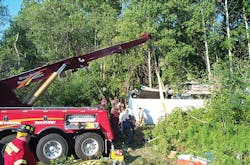Finding Outside Agencies for Technical Rescue Resources
Specialization in the emergency response community has taken on many new faces over the past decade. Today’s responders are being asked to mitigate more and more complex incidents all the time.
Most agencies cannot afford to possess all the equipment to accomplish these varied tasks. To bridge the gap in acquiring these specialized pieces of equipment, many agencies are reaching out to neighboring departments, other municipal agencies and to the private sector for assistance. By bringing all of these components together the success rate at these low-frequency/high-hazard incidents increases significantly.
Trench Rescue
Trench rescue incidents require the movement and removal of tons of earth and other materials to extricate the victims in a timely manner. To accomplish this task with hand tools would overwhelm our resources and create potentially fatal delays in care for the trapped victim(s).
To address this challenge many departments have established working partnerships with local public works agencies to obtain vacuum trucks to assist at trench operations. Pre-planning is an essential part of making this activity successful. Work with you local agencies to create these partnerships prior to an incident happening. These specialized vehicles can be very dangerous when in the wrong hands. Working alongside a trained operator will help maximize the value these and other specialized pieces of equipment can bring to your scene.
Listed are a few of your pre-planning and scene control concerns to consider when you choose to utilize a vacuum truck:
- Ensuring access to the incident site for the vacuum truck when requested. I have heard a number of stories where the equipment was requested, dispatched to the scene and it ends up stuck in a traffic jam of fire apparatus and various other support vehicles from fire, law enforcement and EMS. Scene control extends beyond the trench itself.
- Depending on how large of an incident you are handling, you may need to have additional vacuum trucks staged. Even though these are large vehicles they still have capacity limits and once it is reached you need to rotate it out. As the old saying goes “better to be looking at it than looking for it”; be proactive not reactive to stay ahead of the incident.
- Consider utilization of one of the specialized rescue tools that attach to the vacuum truck. Our county’s special operations unit uses the Rescue Vac system, which provides us greater reach and manageability of the vacuum tubes. This particular system also has an inline device that allows us to break the vacuum in the event that something within the operation takes a negative turn, thus protecting the rescuers and victim from injury.
Complex Motor Vehicle Accidents
Complex motor vehicle incidents are another area that we can benefit from bringing in specialized equipment. Working with a heavy rigging and towing company in your area will bring not only additional equipment to the scene; you will also gain the extensive experience that many of the wrecker operators bring with them. Large towing companies are a specialty in and of themselves; their knowledge of forces created during winching or stabilization operations are priceless when you are faced with an incident of this magnitude.
Just recently, our community experienced a multi-vehicle accident that included a dump truck overturned across a culvert; the dump truck was resting in an unstable manner and its load of stone spilled on top of one of the other accident vehicles.
The incident commander called for the assistance of a local heavy towing company immediately. This sort of decision making is exactly what a good leader will do when faced with the complexities of an incident of this magnitude. Additionally, the success of this operation was directly related to the pre-planning, which the department had accomplished prior to the incident. Knowing the local resource, and having a working relationship with them, allowed for a quick and efficient response.
This particular incident resulted in the use of three heavy wreckers; two were used to stabilize the overturned dump truck, while the third was attached to the passenger vehicle in the culvert utilizing its cable and winch system to lift the vehicle from the stones that had been dumped on it and moved it onto the road surface so that the extrication process could be completed.
An additional resource that over-the-road towing companies bring to your scene is high-lift air bags. These low- and medium-pressure bags are utilized in both stabilization and up righting of large vehicles that have overturned during an accident. Most fire departments today carry a very robust cache of high-pressure air bags; however, the number of departments carrying the low- and medium-lift bags is significantly less in the region I come from.
Additional Resources
- Unimogs; these are short-wheel-based, high-axle vehicles used to inspect and do work in large underground tunnels. It will be of great value during high-water incidents, off-road responses and as an equipment transport at other rough terrain events.
- Robotic cameras: these units traditionally inspect tunnels and culverts for damage on a regular basis. A piece of equipment of this nature would be very valuable for recognizance in certain confined space locations, searching for a lost person who may have taken shelter in a large culvert or other tough to access locations.
One of best command officers I have worked with in my career lived by the theory “no good team meets in the huddle.” Those words sum up so much of our duties in the emergency response world. There are probably many other types of specialized vehicles and equipment available in your community; take a few moments to familiarize and train your department with those options prior to your next specialized incident.
BOB DUEMMEL is the technical rescue editor for Firehouse Magazine and Firehouse.com. He is also the deputy coordinator for Special Operations in Monroe County, N.Y. and a captain with the City of Rochester Fire Department. He is the Plans Manager for New York Task Force-2 USAR Team, a member of the Western New York Incident Management Team and a member of the New York State Technical Rescue curriculum development team. He is a nationally certified instructor with a focus on technical rescue programs. He has delivered training to fire service, industrial, military and international rescue teams and has assisted with exercise evaluation for the United Kingdom and the European Union's USAR program. Bob has also participated in numerous USAR exercised as both a participant and evaluator. He is host of “The Buzz on Technical Rescue” podcast. Bob can be reached at [email protected].
About the Author
Bob Duemmel
Bob Duemmel was the technical rescue editor for Firehouse Magazine and Firehouse.com. A deputy coordinator for Special Operations in Monroe County, NY he recently retired as a captain with the City of Rochester Fire Department. Bob's involvement in technical rescue is very diverse. He is the Plans Manager for New York Task Force-2 USAR Team, a member of the Western New York Incident Management Team and a member of the New York State Technical Rescue curriculum development team. He is a nationally certified instructor with a focus on technical rescue programs. He has delivered training to fire service, industrial, military and international rescue teams and has assisted with exercise evaluation for the United Kingdom and the European Union's USAR program. Bob has also participated in numerous USAR exercised as both a participant and evaluator. He hosted “The Buzz on Technical Rescue” podcast.

